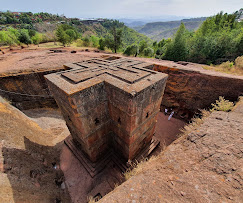LALIBELA

Comprising eleven churches and two chapels, Ethiopia’s labyrinthine ‘New Jerusalem’, excavated by King Lalibela in the 12th century and still in active use today, has been dubbed the “Eighth Wonder of the World”. Hand-carved into the rock flake by painstaking flake, a process that would have required around 40,000 man-years to complete, Lalibela represents the apex of an Ethiopian church-excavating tradition that dates to the arrival of Christianity circa 350 AD.
The rock-cut churches of Lalibela are a unique complex of eleven monolithic churches located in the mountainous region of Ethiopia's heartland, about 645 km from Addis Ababa. Their construction, which dates back about 800 years, is attributed to King Lalibela, an important figure in the country.
Lalibela is a town in the Amhara region of northern Ethiopia. It's known for its distinctive rock-cut churches dating from the 12th and 13th centuries, which are pilgrimage sites for Coptic Christians. Carved out of rock, the subterranean monoliths include huge Bete Medhane Alem, and cross-shaped Bete Giyorgis. Many are joined by tunnels and trenches, and some have carved bas-reliefs and colored frescoes inside.
- Many of Lalibela’s churches are subterranean monoliths, created in two stages. First, a quadrangle of trenches up to 15 meters deep would be hand-cut into a horizontal rock surface. Only then could the artisans commence work on the actual church, which was excavated into a massive freestanding central block enclosed by the artificial trenches.
- The church of Bete Medhane Alem, set in one such subterranean courtyard, is the world’s largest rock-hewn excavation, supported by 36 internal and 36 external pillars.
- The most iconic church at Lalibela, Bete Giyorgis is a free-standing monolith carved in the shape of a cross and dedicated to its namesake Saint George. Legend has it that Saint George was so delighted when he saw his church that he rode his horse right over the entrance tunnel, leaving behind hoof prints that are still visible today.
- The impact of Lalibela is not limited to its architecture. This is also one of the very few UNESCO World Heritage Sites of comparable vintage that functions as a living shrine, one whose ancient stone churches have remained in active use since their excavation almost nine centuries ago.
- The countryside around Lalibela is studded with many other ancient churches. These include Yemrehanna Kristos, one of the finest surviving examples of Aksumite architecture, constructed in the 11th century with alternating layers of wood and gypsum-faced granite.
When you visit Ethiopia, one place you shouldn’t miss is Lalibela’s rock-hewn churches. Located in the highlands of northern Ethiopia, these medieval churches were carved directly out of rock.
Built in the 12th and 13th centuries, they showcase the impressive skills of Ethiopian craftsmen. The churches are not just historical monuments; they are still active places of worship today.
The site consists of 11 churches, divided into two main clusters. The most famous of these is Bet Giyorgis (Saint George). This church stands alone and is often considered the most striking.
Walking through the site, you will see intricate carvings and unique architectural designs. Each church has its own character, from towering columns to detailed crosses etched into the stone.
One interesting fact is that these churches are connected by a series of tunnels and narrow passageways. This adds a sense of adventure as you explore.
Lalibela is also a UNESCO World Heritage Site, recognized for its cultural and spiritual significance. Pilgrims from all over Ethiopia and the world come here to pay their respects.
You’ll find that the local guides are knowledgeable and enthusiastic. Their insights can make your visit even more enriching.
